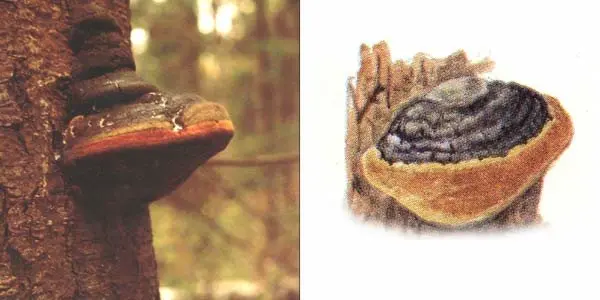Phellinus hartigii (Phellinus hartigii)
- Division: Basidiomycota (Basidiomycetes)
- Subdivision: Agaricomycotina (Agaricomycetes)
- Class: Agaricomycetes (Agaricomycetes)
- Subclass: Incertae sedis (of uncertain position)
- Order: Hymenochaetales (Hymenochetes)
- Family: Hymenochaetaceae (Hymenochetes)
- Genus: Phellinus (Phellinus)
- Type: Phellinus hartigii

fruiting body:
fruiting bodies of the fungus are usually formed in the lower part of the trunk on its northern side. Single fruiting bodies are perennial. Sometimes fruiting bodies grow together in several copies. At first, the fruiting bodies are jelly-like, then cantilevered. Attached wide base. Quite large, about 28 centimeters wide, up to 20 centimeters thick. The upper surface is rough, with wide, stepped zones, at first it has a yellow-brown color, then it changes color to dirty grayish or blackish. As the mushroom matures, the surface cracks and becomes covered with green algae. The edges of the fruit body are rounded, obtuse, ocher-brown or light reddish.
Hymenophore:
rusty brown or yellowish brown. The pores are angular or rounded. The tubules are arranged in several layers, each tubular layer is separated by a sterile layer.
Pulp:
woody, very hard, zonal. On fractures, the pulp has a silky sheen. Yellowish-rusty or yellow-brown.
Spread:
Trutovik Hartig is found in coniferous forests. It grows on conifers, usually on fir.
Similarity:
this species bears a close resemblance to Phellinus robustus, which develops on oak. The difference is the substrate and layers of sterile tissue between the layers of tubules.
Economic purpose:
Gartig’s tinder fungus causes a pale yellow rot that is limited from healthy wood by narrow black lines. This mushroom is a dangerous pest of fir. Trees become infected through broken branches and other wounds. At an early stage of decay, the affected wood becomes fibrous, soft. Brown mycelium of the fungus accumulates under the bark, rotten branches appear. Then, depressions form on the surface of the trunks, in which the fungus forms fruiting bodies.









